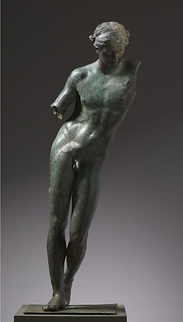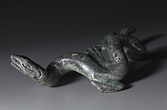DELPHI
Oracles played a large role in ancient Athens, having significance in religion, literature, and philosophy. An oracle is a medium, like an ancient fortune teller, that predicted the future through riddles. She was a connection between the earth and the realm of the gods. The word "oracle" usually refers to the person, but it can also refer to the prophecy or the place where the prophecy was given. Other names for the oracle (the medium) are the Phythia and the Sybill. Delphi is significant because the oracle at Delphi was the most prominent. People from all around the Mediterranean world came to visit her.



THE PRE-TEMPLE SYBILL
It is interesting to me that, before the temple, the Sybill gave prophecies from a rock. This is a chicken-or-egg question (which one came first): did the area around Delphi became sacred because the Sybill gave prophecies there? Or was the Sybill drawn to Delphi because it was sacred? I personally think the latter, because Delphi is "the center of the universe," but it may be a combination, as the place may have become more significant to the Greeks because that was where the Sybill was located.
THE CHARACTER OF THE LISTENER
Because the oracle spoke in riddles, it was up to the listener, with the help of priests, to determine what the riddle meant. This often determined the character of the listener. For example, Lycurgus and Solon used their intellect to interpret the oracle in a way that helped them to establish new policies for Athens that helped improve the city. Croesus, on the other hand, was told that if he made war with the Persians, he will destroy a mighty empire. He was so confident that he would defeat the Persians that he was blind to the fact that his own empire was the one that would be destroyed. Overall, I feel that it would be a difficult task to decipher what the oracle told those who visited her. It could mean fortune or destruction for one's city, depending on how the oracle was interpreted.
THE CENTER OF THE UNIVERSE AND THE FAULT LINES
I am specifically intrigued about Delphi being known as "the center of the universe." According to an ancient myth, Zeus wanted to know where the center of the universe was, so he sent out two eagles in opposite directions around the world, and where they met would be the center. Where they met was Delphi, specifically at the Omphalos, one of two ovular stone statues at Delphi.
As recent as the eighties, the temple of Delphi (specifically the room of the oracle, the Attaton) was discovered to be above an intersection of two fault lines. The lines release ethylene gas, which is likely the gas present in ancient artwork of the oracle.
Could these two stories be connected? Could Delphi being the "center of the universe" have anything to do with the fault lines? Could the eagles have been attracted to the ethylene somehow, or at least the presence of geological activity? This is unlikely because the two points are not in exactly the same place, and the stories appear to be independent events, but I wanted to ask the question nonetheless. Also, while the second story is fact, the first story is a myth.
THE ANCIENT "EMBASSIES"
One thing in Delphi that I would like to learn more about are the treasuries at Delphi and their impact on the ancient world. First, people all over Greece came to Delphi, and then, people all over the ancient Mediterranean world came to visit. Delphi became the "United Nations" or "world bank" of the ancient world. People could talk, negotiate, strategize, and worship with others from all over the world. They began to place all of their things, mostly treasures, in buildings, hence the name "treasuries." Delphi became a neutral territory for all countries to gather and store their things. Many people believe this was how the oracle told her prophecies. She, possibly with the help of priests, would hear conversations from people all over the world, giving her a broad knowledge of what was going on in each country. This was how she could "predict the future," by relaying information that she heard from one person to another.


OTHER MAJOR ORACLES
Delphi is not the only place where an oracle was found, though it was the most significant. Other sites include:
-
The sanctuary of Zeus at Dodona
-
The sanctuary of Trophonius in the cave of Trophonius
-
The sanctuary of Asklepios at Epidauros



A Trip to the Museum
From the Cleveland Museum of Art, Cleveland, Ohio
Title: Apollo the Python-Slayer
When: circa 350 BC
Where: Ernst-Ulrich Walter, Germany (though originally from Greece)
-
I chose this artifact for the site of Delphi because we discussed the story of Apollo killing the python who was the ancient guardian of Delphi. Something that sticks out to me about this statue (and bronze statues in general) is the eyes. From far away, the eyes appear creepy and serpentine, but up close, one can see that the eyes are human (though still a little creepy). The are not detailed with a pupil and an iris, though, if the statue was painted, they could have been painted on. Unlike stone statues, there is a hole representing the iris/pupil, while the eyes of a stone statue would have been painted entirely (if painted at all).
-
Included with the statue are two more artifacts: Apollo's forearm and a reptile or amphibian of some kind. Apollo's left arm and right forearm are missing from the statue, and his left forearm remains separated. His fingers are open slightly, as if reading to hold something (maybe the reptile or amphibian?). I called the creature with him a reptile or amphibian rather than a python because, though the statue is called "Apollo the Python-Slayer," the creature has legs. Snakes do not have legs, but lizards and salamanders do, and the creature appears more like these legged creatures than a python. This statue was formerly known as "Sauroktonos," or "lizard-slayer," which makes more sense to me. So I am wondering, why was the name changed? Was it to better represent the story of Apollo slaying the python? If so, why was he depicted as a lizard-slayer? Also, what happened to him arms? His left forearm remains, but his right forearm and the rest of his left arm are not there. Was he holding anything? And lastly, where is he looking? The statue's eyes are angled down, so was the creature by his feet?
-
One additional comment: Apollo the Python-Slayer resembles a python himself. As I mentioned, his eyes appear serpentine to me from a distance, and the way the statue is leaning appears somewhat snakelike as well.